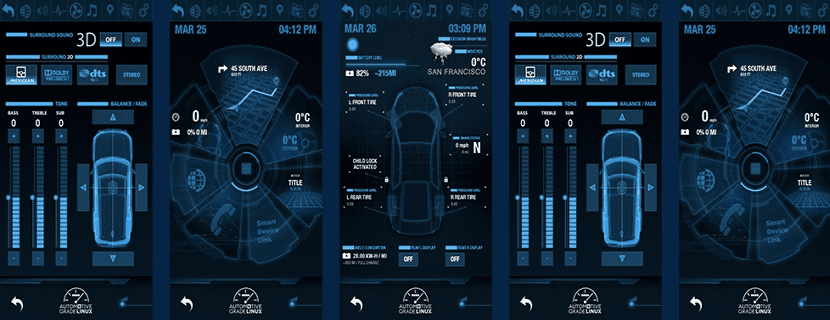
The Linux Foundation has presented the seventh version of the AGL UCB distribution (Automotive Grade Linux Unified Code Base), which is developing a universal platform for use in various automotive subsystemsfrom dashboards to automotive infotainment systems.
The distribution is based on the projects of Tizen, GENIVI and Yocto. The graphical environment is based on Qt, Wayland and the Weston IVI Shell project. The mounting platform consists of QEMU, M3 boards, Intel Minnowboard Max (Atom E38xx), TI Vayu, and Raspberry Pi 3.
Companies like Toyota, Ford, Nissan, Honda, Jaguar Land Rover, Mazda, Mitsubishi and Subaru are involved in the development of the project.
About Automotive Grade Linux
AGL UCB can be used by car manufacturers as a framework to create final solutions, after making the necessary adaptation for the equipment and customizing the interface.
The platform will It allows you to focus on application development and your own methods of organizing the user's work, without thinking about low-level infrastructure and minimizing maintenance costs.
A set of working prototypes of generic applications written with HTML5 and Qt technologies is provided.
For example, there is an implementation of the home screen, the web browser, the dashboard, the navigation system (using Google Maps), the climate control, a media player with DLNA support, an interface to configure the subsystem of audio and a news reader.
The components are offer for voice control, information retrieval, interaction with a smartphone via Bluetooth and connection to a CAN network to access sensors and transfer data between vehicle nodes.
The project is completely open: all components are available under free licenses. The source code of the available project developments it is via git.
Changes in the seventh version of Automotive Grade Linux

As was said at the beginning, the seventh version of Automotive Grade Linux was announced which comes with the API for speech recognition and synthesis (speech recognition and speech API) based on connected open engines.
Operation by voice commands
Support for voice control and use in web applications has been added to the HVAC APIs (air conditioning control) and telephony.
SmartDeviceLink has been added in this release to link applications running on smartphones with car infotainment systems.
Technology allows you to organize interaction with mobile applications (compatible with Apple CarPlay and Android Auto) using standard automotive interfaces such as a touch screen on the console, a voice command recognition system, and additional buttons and keys.
Web Applications
The additional device profiles for telematics, dashboards, and a component to manage the lifecycle of WAM web applications (Web Application Manager) integrates with the AGL application framework and enables you to run web applications as native programs.
The layer for launching web applications is based on the Chromium engine which offers a set of demo web applications for download.
The reference suite has been updated, including a media player, a tuner, a navigation system, a navigator, interfaces for configuring Bluetooth, WiFi and HVAC, a sound mixer and a panel to control the car's subsystems.
An interface to control the volume and the implementation of a virtual sound card (Dynamic Virtual ALSA) has been added to the number of reference applications.
Of the other characteristics that stand out are:
- The possibility of a separate set of basic AGL services (Core AGL Service).
- The ability to simultaneously display information on multimedia screens and control panels.
It does not support multi-screen output, including a rear passenger multimedia screen. - Support for various hardware platforms, including Qualcomm Technologies, Intel, Texas Instrument, NXP, and Raspberry Pi boards.
- Availability of SDK (Software Development Kit) with typical application templates.
If you want to know more about it, you can visit the project website. The link is this.